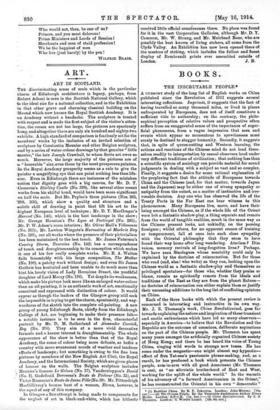ART.
ART IN SCOTLAND.
TEE discriminating sense of scale which is the particular -charm of Edinburgh architecture (a legacy, perhaps, from Robert Adam) is seen in the Scottish National Gallery, which 4s the ideal size for a national collection, and in the Exhibition in that other grave and charming classical building on the Mound which now houses the Royal Scottish Academy. It is aim Academy without a headache. The sculpture is treated with respect and is made the first subject of the visitor's atten- tion, the rooms are not too large, the pictures are spaciously bung, andaltogether there are only six hundred and eighty-two exhibits. A high standard of comparison is fearlessly set for the members' works by the inclusion of an invited selection of sculpture by Constantin Meunier and other Belgian sculptors, and by a series of water-colour drawings by that genuine " little 'Imaster," the late Joseph Crawhail, to whom Scots art owes so much. Moreover, the large majority of the pictures are of " homeable " size, even those by the most prosperous painters. in the Royal Academy prosperity seems as a rule to give the -painter a magnifying eye that can paint nothing less than life- alize. Even in Edinburgh there are instances of the mistaken 'notion that dignity goes with a big canvas, for Mr. D. Y. 'Cameron's Stirling Castle (No. 398), like several other recent works from his skilful hand, would have been more significant on half the scale. But Mr. Peploe's three pictures (Nos. 965, '298, 336), which show a quality and structure and a .subtle skill of drawing in paint that lift his art to the Mighest European level of technique; Mr. D. Y. MacGregor's Hama (No. 146), which is the best landscape in the show ; Mr. George Houston's The Lyon at Fortin gal (No. 295); arr. P. W. Adam's room interiors ; Mr. Oliver Hall's Villeneuve (No. 383); Mr. Lawton Wingate's Harveating at Machrie Bay (No. 395),„ are all works where the pressure of their pictorialism . has been maintained to the last touch. Mr. James Paterson's Coming Storm, Touraine (No. 142) has a correspondence of touch and draughtsmanship to its conception which makes it one of his few really complete works. Mr. E. A. Walton fails lamentably with his large composition, The Mother (No. 196), a patchy work without design; and even Sir James Guthrie has hesitated and been unable to do much more than Lint his lovely vision of Lady Hermione Stuart, the youthful daughter of Lord Moray (No.186). Yet despite its weaknesses, which make his picture look more like en enlarged water-colour than an oil-painting, it is an authentic work of art, emotionally conceived and expressed with distinction of colour. It would appear as though the leaders of the Glasgow group'still seek the impossible in trying to get the charm, spontaneity, and way- wardness of the sketeh into the complete oil-painting. A new group of young Edinburgh Scots, chiefly from the Edinburgh College of Art, are beginning to make their presence felt- s notable instance is to be seen in the firm, characterful portrait by Mr. D. IL Sutherland of Alexander Carrick, Bag. (No. 376). They aim at a more vivid decorative formula and a keener interest in draughtsmanship. The whole appearance of the show is better than that of the Royal Academy, the sense of colour being more delicate, as befits a country with more evanescent moods of weather and tenderer effects of landscape ; but something is owing to the fine loan pictures by members of the New English Art Club, the Royal Academy, and the International Society, which are given places of honour on the walls. The Belgian sculptare includes Meunier's famous Le Grisou (No. 17), Vanderstoppen's David (No. 1), Godefroid Derreese's Busts de Pleheur (No. 35), and Victor Rousseau's Baste de Jenne l'ille(No.38). Mr. Pi ttendrigh hfacGillivray's bronze bust of a woman, Bhrna, however, is the equal of any of this company.
In Glasgow a fine attempt is being made to compensate for the neglect of art in black-and-white, which has hitherto
received little official countenanee there. No place was found for it in the vast Corporation Galleries, although Mr. D. Y. Cameron, Mr. W. Strang, and Mr. Muirhead Bone, who are possibly the best -known of living etchers, all come from the Clyde Valley. An'xhibition has now been opened there of the masters of etching, which includes the fullest and finest display of Rembrandt prints ever assembled outside of










































 Previous page
Previous page